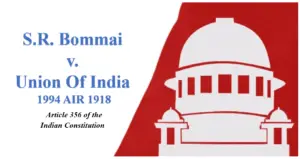
Introduction
- In the annals of India’s legal history, few cases have had as profound an impact as the S. R. Bommai v. Union of India. Decided by a nine-judge bench of the Supreme Court in 1994, this case established crucial precedents regarding the application and limitations of Article 356 of the Indian Constitution.
- As we commemorate its 30th anniversary, it’s imperative to delve into the background, judgment, and significance of this landmark case.
Background of S. R. Bommai v. Union of India
- The case arose from the dismissal of the Karnataka state government led by S. R. Bommai in 1988, under Article 356, following defections by legislators.
- Bommai’s challenge to the dismissal set the stage for a comprehensive examination of the powers vested in the President and the Governor under Article 356.
Supreme Court Judgment:
- The Supreme Court’s verdict in the S. R. Bommai case laid down crucial principles:
- Emphasized cautious exercise of Presidential Proclamation under Article 356.
- Mandated parliamentary scrutiny and judicial review of such proclamations.
- Recognized limitations on the President’s power to dismiss state governments.
- Affirmed the role of the judiciary in upholding constitutional principles and preventing misuse of power.
Significance of S. R. Bommai v. Union of India Case:
- The judgment’s significance reverberates across several dimensions:
- Safeguarding Federalism: By curbing arbitrary dismissals of state governments, the judgment reinforced the principles of federalism and cooperative governance.
- Upholding Constitutional Values: It underscored the importance of adherence to constitutional principles, preventing their subversion for political expediency.
- Judicial Oversight: The case strengthened the judiciary’s role in scrutinizing executive actions, ensuring accountability and the rule of law.
- Clarifying Constitutional Ambiguities: Through its interpretation of Article 356, the judgment provided clarity on the scope and limitations of executive powers.
Article 356 of the Indian Constitution:
- Understanding Article 356 is pivotal to grasp the context of the S. R. Bommai case:
- Grounds for Imposition: The article allows for the imposition of President’s Rule on states in case of failure of the constitutional machinery.
- Conditions and Constraints: It delineates the process, duration, and limitations of such imposition, subject to parliamentary approval and judicial scrutiny.
- Proper vs. Improper Use: The Sarkaria Commission outlined conditions warranting or prohibiting the exercise of power under Article 356, providing a framework for its judicious application.
Cooperative vs. Competitive Federalism:
- The concepts of cooperative and competitive federalism elucidate the dynamics between the center and states:
- Cooperative Federalism emphasizes collaboration and shared governance for mutual benefit, fostering unity in diversity.
- Competitive Federalism fosters healthy competition among states for development and resource allocation, driving efficiency and innovation.
Conclusion:
- The S. R. Bommai v. Union of India case stands as a testament to the resilience of India’s constitutional framework and the judiciary’s role in upholding its integrity.
- As we reflect on its legacy, it’s imperative to reaffirm our commitment to federalism, constitutional values, and the rule of law, ensuring that the spirit of justice and accountability endures for generations to come.
People also ask
Q1: What is the S. R. Bommai v. Union of India case?
Ans: The S. R. Bommai v. Union of India case is a landmark judgment delivered by the Supreme Court of India in 1994. It dealt with the arbitrary dismissal of state governments under Article 356 of the Indian Constitution and established crucial precedents regarding the application and limitations of this article.
Q2: What was the background of the S. R. Bommai case?
Ans: The case originated from the dismissal of the Karnataka state government led by S. R. Bommai in 1988 under Article 356. This followed defections by legislators, leading to a political crisis and subsequent legal challenge by Bommai against the dismissal.
Q3: What were the key principles laid down by the Supreme Court in the S. R. Bommai case?
Ans: The Supreme Court emphasized cautious exercise of Presidential Proclamation under Article 356, mandated parliamentary scrutiny and judicial review of such proclamations, recognized limitations on the President’s power to dismiss state governments, and affirmed the judiciary’s role in upholding constitutional principles.